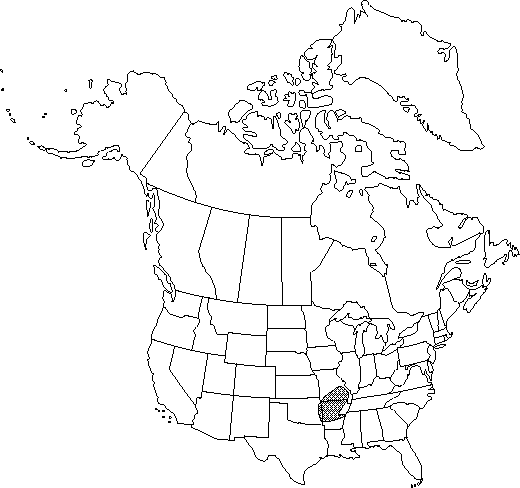Difference between revisions of "Hamamelis vernalis"
Trees & Shrubs 2: 137-138. 1908.
FNA>Volume Importer |
FNA>Volume Importer |
||
| Line 24: | Line 24: | ||
}}<!-- | }}<!-- | ||
| − | --><span class="statement" id="st- | + | --><span class="statement" id="st-undefined" data-properties=""><b>Shrubs,</b> 2-4 m, stoloniferous, with widespreading roots. <b>Leaves</b> often persistent in winter; petioles 7-15(-18) mm. <b>Leaf</b> blade mostly obovate, 7-13 × 6.7-13 cm, base narrowed to somewhat cuneate, rarely rounded and weakly oblique, apex acute or rounded; surfaces often abaxially glaucous. <b>Flowers</b> appearing in winter on naked branches, distinctly fragrant; calyx often adaxially deep purple; petals reddish or deep red to orange, occasionally yellow, 7-10 mm; staminodes not dilated or slightly so. <b>Capsules</b> 10-15 mm. <b>Seeds</b> 7-9 mm. <b>2n</b> = 24.</span><!-- |
-->{{Treatment/Body | -->{{Treatment/Body | ||
| Line 57: | Line 57: | ||
|publication year=1908 | |publication year=1908 | ||
|special status=Endemic | |special status=Endemic | ||
| − | |source xml=https://jpend@bitbucket.org/aafc-mbb/fna- | + | |source xml=https://jpend@bitbucket.org/aafc-mbb/fna-data-curation.git/src/9216fc802291cd3df363fd52122300479582ede7/coarse_grained_fna_xml/V3/V3_998.xml |
|genus=Hamamelis | |genus=Hamamelis | ||
|species=Hamamelis vernalis | |species=Hamamelis vernalis | ||
| − | |||
| − | |||
| − | |||
| − | |||
| − | |||
| − | |||
| − | |||
| − | |||
| − | |||
| − | |||
| − | |||
| − | |||
| − | |||
| − | |||
| − | |||
| − | |||
| − | |||
| − | |||
| − | |||
| − | |||
| − | |||
| − | |||
| − | |||
}}<!-- | }}<!-- | ||
-->[[Category:Treatment]][[Category:Hamamelis]] | -->[[Category:Treatment]][[Category:Hamamelis]] | ||
Revision as of 14:55, 27 July 2019
Shrubs, 2-4 m, stoloniferous, with widespreading roots. Leaves often persistent in winter; petioles 7-15(-18) mm. Leaf blade mostly obovate, 7-13 × 6.7-13 cm, base narrowed to somewhat cuneate, rarely rounded and weakly oblique, apex acute or rounded; surfaces often abaxially glaucous. Flowers appearing in winter on naked branches, distinctly fragrant; calyx often adaxially deep purple; petals reddish or deep red to orange, occasionally yellow, 7-10 mm; staminodes not dilated or slightly so. Capsules 10-15 mm. Seeds 7-9 mm. 2n = 24.
Phenology: Flowering winter (Dec–Mar).
Habitat: Gravel bars and rocky stream banks, developing thickets, rarely on wooded hillsides
Elevation: 100-400 m
Distribution

Ark., Mo., Okla.
Discussion
In the original description of Hamamelis vernalis, C. S. Sargent erroneously figured the flowers of H. virginiana (plate 156) and failed to mention either the fragrance or the distinctive color range of the flowers in H. vernalis. He stated only that the petals were light yellow.
Hamamelis vernalis is restricted to the Ozark Plateau of Missouri, Oklahoma, and Arkansas, often in close proximity with the more widespread H. virginiana. It is difficult to explain the restricted occurrence of H. vernalis in the Ozark area, although ancient geology of the area, with predominently Paleozoic rocks, makes it a well-known refugium. Hamamelis vernalis and H. virginiana are sympatric, sometimes growing within 30 m of each other, yet their identity is maintained, and the two species are easily distinguished through a composite of diagnostic characters (J. L. Bradford and D. L. Marsh 1977). Hamamelis vernalis shows an unusual color range of the flowers. Plants growing side by side commonly differ in flower color, varying from orange to deep red or, occasionally, deep yellow. Sometimes flower color varies on the same plant; e.g., petals that are initially deep red can later fade to yellow.
Hamamelis vernalis is not well known in cultivation and is infrequently planted. It is desirable for the fragrance and color variation of the flowers.
Selected References
None.